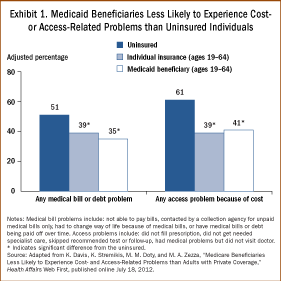In the wake of June’s Supreme Court ruling largely upholding the constitutionality of the Affordable Care Act, many states have continued to make significant progress instituting important insurance market reforms, laying the groundwork for creation of health insurance exchanges, and preparing to expand coverage to low-income adults through Medicaid. But with expansion of Medicaid now voluntary, several states have indicated that they will turn down their share of the billions of federal dollars available for expanding the program. Proposals to repeal the expansion entirely through the legislative process and replace Medicaid with a block grant to states are also receiving renewed attention.
The Congressional Budget Office now projects that 30 million previously uninsured Americans will gain coverage by 2022, 3 million fewer than had been predicted after the law was passed but before the Supreme Court decision. Post-reform Medicaid enrollment is expected to be about 6 million less than the 17 million people previously projected by the Congressional Budget Office, but an increase in enrollment through the new health insurance exchanges is expected to absorb some of that loss. Overall, about 92 percent of the nonelderly population residing in the country legally is expected to have coverage in 2022.
Expanding coverage will reduce unrecoverable hospital debts for care of those who were previously uninsured. This was the primary rationale for trimming annual increases in payments to hospitals under Medicare by one percentage point annually. These adjustments—along with reducing overpayments to Medicare managed care plans and other providers—constitute the $716 billion in Medicare savings that will be used to help finance expanded coverage of the uninsured, improve benefits for Medicare beneficiaries, and make other investments in prevention and population health. Repealing the coverage provisions but keeping the reduced payments would make it difficult for hospitals to afford the bad debts that come from providing care to the resulting higher numbers of uninsured. Repealing the law entirely would increase the federal deficit by $109 billion over the next decade.
While state policy leaders must contend with a number of issues when deciding whether to expand Medicaid under the Affordable Care Act, some well-established facts are worth considering. First, Medicaid, like Medicare, fulfills the two main purposes of health insurance—ensuring access to needed care and providing adequate financial protection from burdensome medical expenses. Evidence from a study on Medicaid enrollment in Oregon found that participants who received coverage through the program were able to visit the doctor more and reported better health and financial stability than those without coverage.
These findings parallel our recent research comparing the experiences of individuals with different types of insurance. In particular, we found that Medicaid beneficiaries were significantly less likely than the uninsured to experience access problems because of cost as well as medical debt or bill problems. Moreover, Medicaid beneficiaries reported such problems at rates comparable with those with private individual insurance (Exhibit 1). 
Further research confirms that expanding Medicaid not only improves access to care and financial protection of vulnerable individuals and families, but actually saves lives. A recent study found that Medicaid expansions in New York, Maine, and Arizona over the past decade have reduced mortality rates, particularly among older adults, racial minorities, and residents of poorer counties, relative to comparable states that have not had such expansions. These findings confirm that Medicaid is a crucial means to reducing the health consequences of being uninsured—the Institute of Medicine has estimated that 18,000 people died in 2000 because they lacked health insurance. More recent research by the Urban Institute suggests that the number increased to 22,000 in 2006.
Many Americans experience these benefits of Medicaid coverage, including individuals with disabilities and elderly middle-class adults who exhaust their savings and have no other way of paying for long-term care as they age. In fact, more than half of all adults in the United States have reported some personal connection to the program, by receiving health insurance, assistance with Medicare premiums, or support for long-term care for themselves, a family member, or friend. A similar proportion says that Medicaid is important to them and their family.
The health reform law builds on the success of the Medicaid program in ensuring access to care and financial protection for vulnerable individuals and families. Starting in 2014, states have the option to expand Medicaid coverage to all adults earning less than 133 percent of the federal poverty level, or about $31,000 for a family of four. The federal government will pick up 100 percent of the costs to states through 2016, and then gradually phase down their contribution to 90 percent by 2020. The rate will be maintained at that level in the years beyond.
States that choose to forgo the significant amount of federal aid available to expand Medicaid not only would deprive vulnerable families of participation in an effective program, but also would miss an important economic stimulus for their state as a whole. Scholars have noted that states skipping expansion will miss an opportunity to lower the costs of uncompensated care for their hospitals and an infusion of federal dollars for traditionally underserved and rural areas. One estimate suggests that full implementation would save states at least $90 billion between 2014 and 2019 by reducing uncompensated care and expanding treatment for individuals with mental illnesses.
In each of the past two years, the U.S. House of Representatives passed a budget framework that would repeal the health reform provisions expanding Medicaid and replace the current program with a block grant to states tied to the annual increase in inflation and the total U.S. population, rather than the increase in medical costs. Federal spending on the program would fall dramatically beginning in 2022 and be 76 percent to 78 percent lower than what is otherwise projected to occur by 2050. By shifting such a disproportionate share of the costs onto states and beneficiaries who can least afford to bear it, cutting federal Medicaid funding can be expected to leave many millions of people without coverage, including seniors in nursing homes, people with disabilities, children, and pregnant women.
Medicaid is a critical public program that works for beneficiaries far sicker and more expensive to care for than those typically covered by private insurance. Expanding eligibility for Medicaid under the Affordable Care Act is an effective means to ensure vulnerable patients and their families get access to needed care and are protected from ruinous medical bills. States that choose not to participate in the expansion not only place the health and well-being of their citizens at risk, but they forgo an important opportunity to strengthen their local health care delivery systems by placing them on more stable financial footing.

